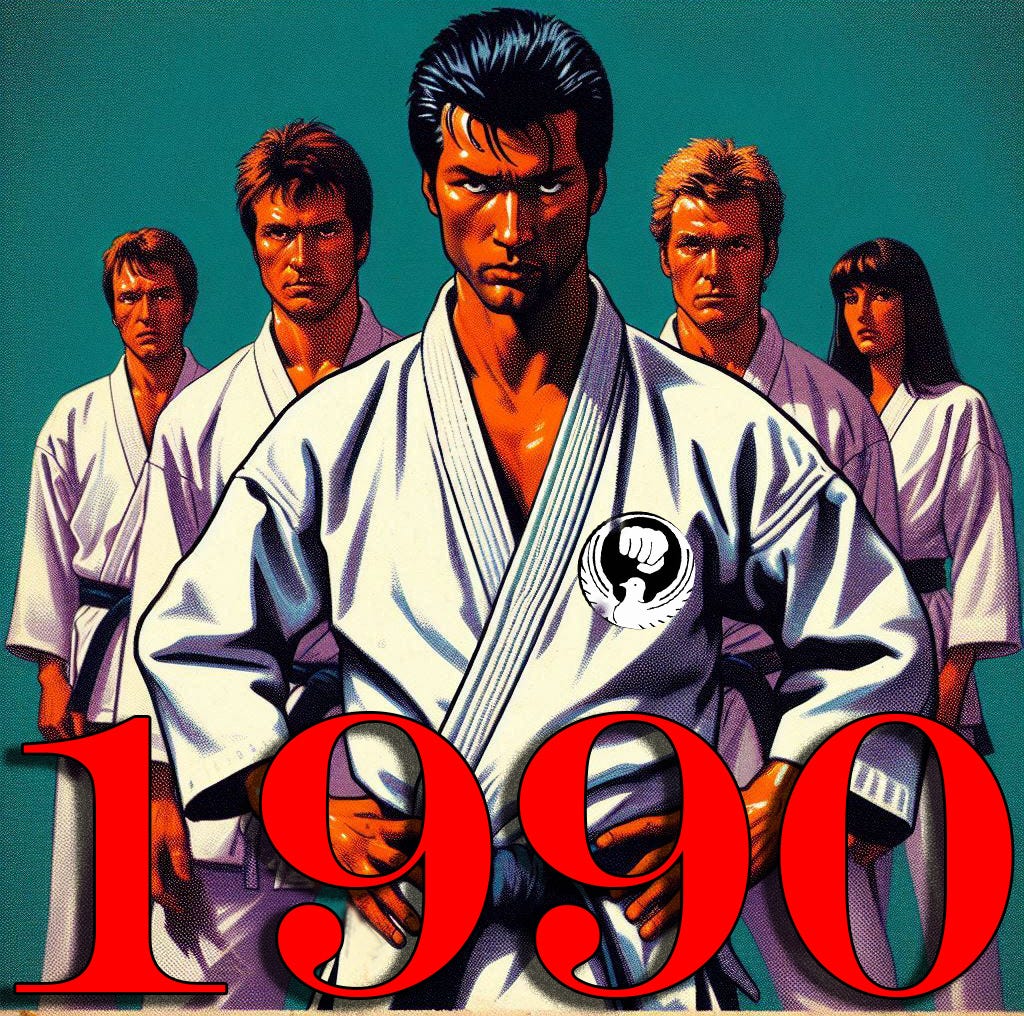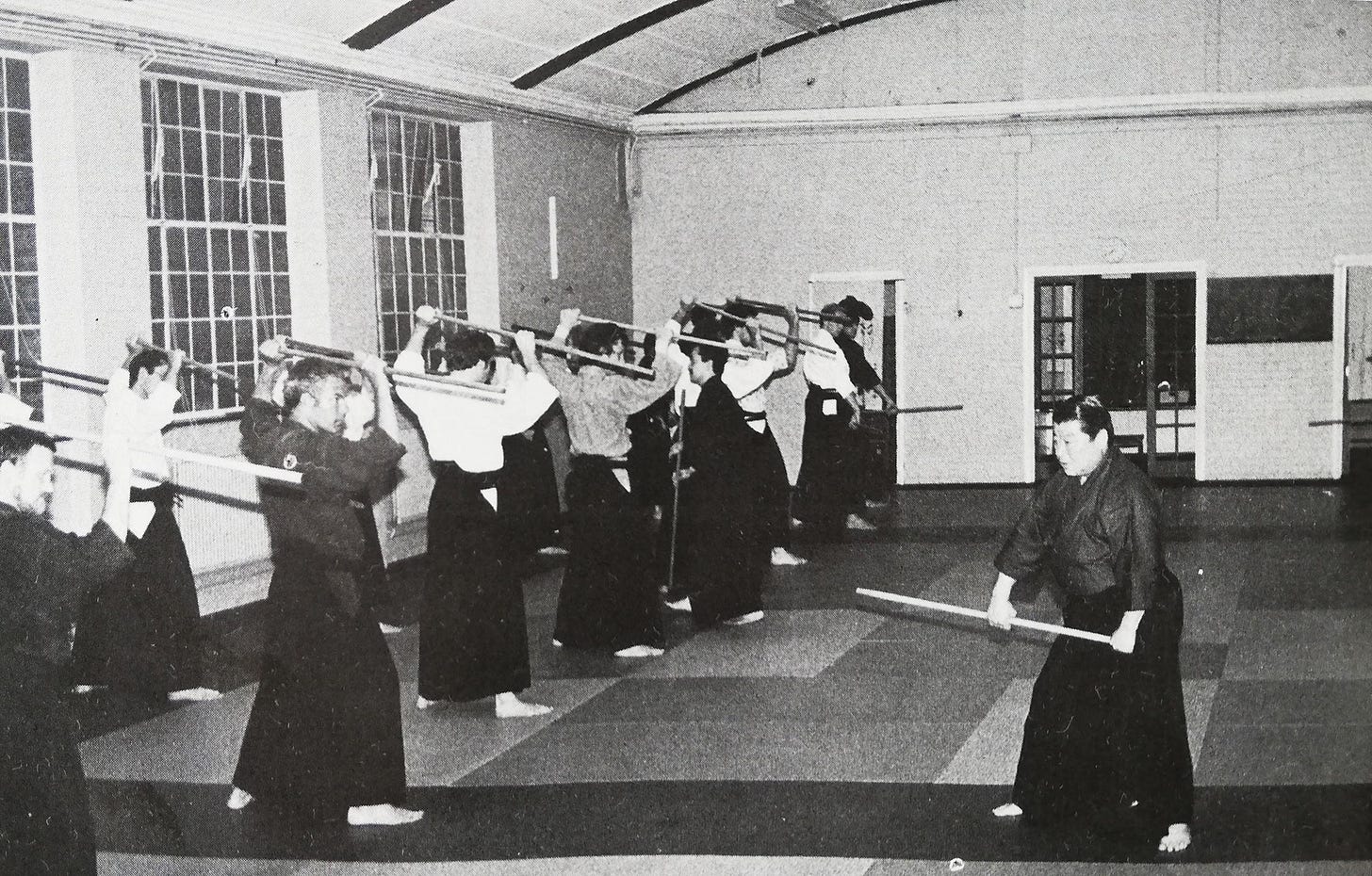In this piece:
· Shuffling the order; who was in and who was out.
· Phone conversations and reports back from meetings.
· The loyalty issue.
· ‘Suzuki-Ha’ Wado Ryu.
· The new syllabus, as produced by the Academy.
· Mode of delivery.
· New terminology, new techniques.
· New paired kata and the jettisoning of the Suzuki versions. What was lost and what was gained.
· Otsuka Sensei explains the so-called ‘higher’ kata on the 1990 Summer Course.
· Shiomitsu Sensei.
It is difficult to piece together the post-89 Wado karate world picture at a micro level, because of how everything happened. I am reminded of Hemmingway’s response to the question, ‘Tell me, how did you go bankrupt?’, his answer, ‘Two ways; gradually, then suddenly’. So it was with the unravelling of the Japanese alliance in Wado Ryu karate.
There were a smattering of events going on in UK Wadoland and the calendar was rapidly filling up. There seemed to be a lot of energy exploding in different directions; so much so that it was difficult to keep track of it.
An example:
In January 1990 was the first Academy course in at the Yawara Centre in Wandsworth. My journal tells me that it was at the end of training that Takamizawa Sensei was awarded a certificate for 6th Dan and Sakagami Sensei for 7th Dan, all under the authority of the Renmei. Sakagami Sensei’s stay in the Academy was very short indeed. No sooner was he in, but then he was out again. The stories I heard were that was pulled in several directions at once and somehow, he’d calculated that he had made a misstep in his future planning.
Long-time well-established (and much respected) instructor, Tony Heap from Chiswick was in and then he was out (I am not even sure what happened there). He was definitely there at this course in Wandsworth, and later at the 1990 Summer Course (see below).
I wrote about my conversation with Takamizawa Sensei on this particular day in my previous piece, ‘Let’s Dance’, https://budojourneyman.substack.com/p/lets-dance
The only photo I could find of the interior of the Yawara Centre in Wandsworth. Nothing to do with Wado karate but, this one is a Jodo course conducted in 1984. (Photo credit: Karate and Oriental Arts Magazine, issue No. 111).
Phone calls.
A complicated series of meetings occurred early in 1990. I had enough irons in the fire to get a measure of what was happening. I wasn’t at those meetings, I wasn’t invited (much to my annoyance at the time, but who was I anyway?). I knew that the implications might turn everything on its head and I was worried that the whole applecart would just implode and the garden of Eden we’d all been living in would just evaporate, like some kind of mirage.
But, phone calls with those who were there gave me a flavour of the way things were going, and it didn’t look good.
To give you a feeling of how fortunate (or even entitled) we felt we were; fast forward a few years…
Premier League.
Some time later, though really not so long after these events, I got involved in an exchange on line with another Wado instructor who took exception to what he perceived as my ‘elitism’ as regards to Wado (at a simple level, I guess he was right, but…)
To cut a long story short; one of his Dan grades came to train at my Dojo for about six months. An open-minded guy who very quickly realised he was being sold short at his home Dojo and that his Shodan grade was meaningless in the wider world of Wado. I didn’t want to get involved but somehow I was suckered into an email exchange with his instructor, this particular ‘King of his own backwater’.
Part of this exchange was him saying to me that he was quite content to wallow in the stagnant shallows. He said, “Not everyone can be Manchester United”, and although I held back the impulse to say it, I wanted to respond with, “Well we are”.
I know that sounds arrogant, but, so confident were we in the hangover from the pre-1998 world of Wado that we still considered ourselves the only game in town. As we saw it, there was nobody else.
In Wado terms we had previously held all the cards. The team of Japanese instructors were truly stellar (and, in our over-confident complacency, we took it all for granted). The international squads we were able to assemble at a time when competition karate was a game for all-rounders, were a glittering constellation of talent. These were fighters whose skills were forged through the multiple rounds of huge tournaments. Something that can only be dreamt of today. I won’t mention names, because I don’t need to.
This was another reason why the implosion was so catastrophic. How were we ever going to build on that now?
Conversations and meetings.
I can’t quote directly, but I will paraphrase some of the things I heard (mostly over the phone).
There was a conciliatory tone from some quarters, which I could relate to, which basically addressed the ‘Japanese conundrum’. The proposal seemed to be a kind of franchising out of the talents of the Japanese Sensei as hired agents. It was incredibly idealistic, but naïve. A grasping at straws without engaging with the depth of the enmity involved.
Suzuki Sensei was front and centre at most of the meetings and had some strong words to say; I won’t quote or recount the broadsides he fired in various directions, because I wasn’t there.
He railed against individuals, technical heresies, political betrayals (money was mentioned) and generally presented a forceful argument in that indomitable Suzuki way.
I have to be fair to him, he didn’t sit back over the Wado Kai/ Wado Renmei thing in Japan. It is said that he tried to bring the warring factions together but was too distant geographically to hold any sway. And here he was fighting a not so dissimilar battle on his established home turf. I must mention the Wado Kai, who were hardly a force over in the UK at that time. We knew that they had their representatives in Europe, who, as far as I could see, just kept their distance.
But Suzuki Sensei, for all his undoubted talents in karate was no politician. He wasn’t a ‘persuader of men’, with him, it was ‘my way or the highway’. If any kind of compromise was ever on the table I never heard of it.
The final split.
When it became clear that the parting of the ways was inevitable; the separate vehicles of Suzuki Sensei’s newly defined and newly named WIKF and the Wado Academy rumbled into gear.
Engines were being stoked and the word ‘loyalty’ was being thrown around a lot (a word that we’d only encountered before in our martial arts training through Suzuki Sensei’s Dojo Kun). Of course, we knew what loyalty was in the broader sense of its meaning.
I suspect that here again was a culture gap that was always going to be a struggle to get across. At that time westerners were pretty much of the mindset that they were working under the direction of the Japanese Sensei who acted as ‘coaches’. The ‘Sensei’ thing did not really exist in European culture (despite the fact that many Japanese Sensei went out of their way to lay it all out and try their best to clarify how they saw the reality of it as a kind of transaction that was really two-way).
Thus, there were those who muttered away in the background about the Japanese Sensei holding things back. (To be truthful; this was a perennial gripe and kept carouseling round).
In retrospect and in all honesty; if things were ‘held back’ it was because the students weren’t ready for the info. If they had the information they couldn’t do anything with it anyway, because the groundwork hadn’t been done. Where the blame exists on that question is open to debate. Westerners never respond well to that particular critique; they’ve paid their money to their ‘coaches’ and they demanded the goods.
Conversations were happening; there was no sitting on the fence. Instructors were forced into jumping one way or the other.
The first inklings of Suzuki Sensei going off on his own (there were whispers about Wado Kai affiliation that never really materialised in any meaningful way) and the mention of ‘Suzuki-Ha’ Wado Ryu, happened as far back as a meeting in Derby after a Dan grading in November 1989.
This was interesting because we all wondered what ‘Suzuki-Ha’ meant.
The use of ‘Ha’ has a long tradition in the older martial arts; indicating a kind of stylistic sub-category, a defined off-shoot following a particular person’s approach to interpreting the art. People nowadays freely use ‘Suzuki-Ha’ to define what they do as a sub-set of Wado that remains with the model Suzuki Sensei established. I am told that more often than not when ‘Ha’ is attached to someone’s name the understanding is that the named person is no longer alive.
How did I feel at the time?
Note for free subscribers and casual browsers:
To read the remaining half of this article, become a paid subscriber.





